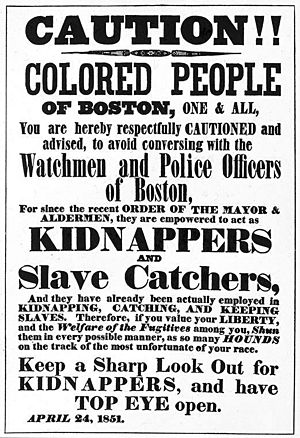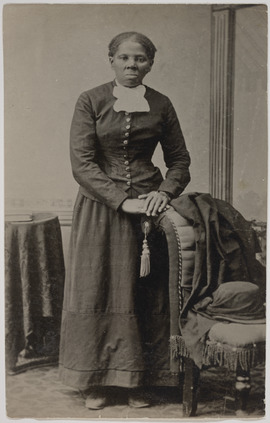Tilly Escape facts for kids
The Tilly Escape happened in October 1856. It was when an enslaved woman named Tilly was guided by Harriet Tubman from slavery in Baltimore to freedom in Philadelphia. Historians who study Tubman say it was "one of her most complicated and clever escape attempts." It was a very risky trip. Tubman and Tilly could not travel directly from Baltimore to Philadelphia. They needed proof that they were free women. Also, local slave traders might have recognized strangers. Tubman tried to avoid being caught by first going south, then heading north. She used different ways to travel, like boats and land vehicles.
Challenges for Escapes

In the 1850s, it became very hard for Harriet Tubman to make trips between Maryland and Canada. She had health problems, which sometimes made her travels slower. Each trip also cost money. White slaveholders became more and more upset. This was because many enslaved people were running away. Also, escape plans needed to be timed perfectly to succeed.
A law called the Fugitive Slave Act of 1850 made things even harder. This law meant that slave traders could travel into the northern, free states. The law even forced people to help find and capture enslaved people who had escaped. Tubman had many plans at once. She was helping five young men escape from the Eastern Shore of Maryland. She was also helping two children get to freedom. She even tried to bring her sister Rachel and Rachel's children north. This became very difficult after Rachel's children were sold away from her.
The Escape Journey
Tilly's fiancé was a formerly enslaved man. He had escaped to Canada in 1848 or 1849 to avoid being sold. He waited for Tilly to join him there. He asked Harriet Tubman to guide Tilly from Baltimore. He also gave Tubman money to help with the costs of the trip.
Tubman made a special arrangement. She got a letter from a steamboat captain in Philadelphia. This letter said she was a free woman from the "city of brotherly love." She traveled on his steamship through the Chesapeake & Delaware Canal to Baltimore. With this letter, she was able to get a pass for Tilly from the steamboat captain. This pass allowed them to travel from Baltimore.

Tubman found Tilly in Baltimore. They traveled to Seaford, Delaware on a steamboat called Steamboat Kent. They went south through Chesapeake Bay for about 40 miles. Then they traveled northeast on the Nanticoke River. They landed in Seaford. One reason for traveling south was to avoid paying a large fee. This fee was $500 in 1856. It was a bond to prove they were free women if they traveled north through Maryland and Delaware.
They spent the night at the only hotel in Seaford. Today, this is the site of Gateway Park. A slave trader found them there. But Tubman showed him their passes, and he let them go. She later remembered praying, "Oh, Lord! You've been with me in six troubles, don't desert me in the seventh!"
In point of courage, shrewdness, and disinterested exertions to rescue her fellow-men, by making personal visits to Maryland among the slaves, she was without her equal.
From Seaford, they walked eight miles north to Bridgeville. Then they traveled north to Camden by train. In Camden, they met William Brinkley. He was a free Black man, a conductor on the Underground Railroad, and Tubman's friend. He took them on the 50-mile journey to Wilmington.
In Wilmington, they went to the house of Thomas Garrett. He was an abolitionist and a leader of the Underground Railroad. He gave Tubman $25 that had been sent to her by Eliza Wigham. This money was very helpful. Tubman could use it for a rescue mission for her sister Rachel. Both Tilly and Tubman also needed new shoes.
They continued on to Philadelphia. Tilly's fiancé met them there, probably at William Still's office. Still was an Underground Railroad operator and a leading abolitionist. Tilly and her fiancé then traveled on to Canada. Tubman went back to Maryland and rescued a family of four people.
Who Was Tilly?
Mary Thompson Bayly put an advertisement in the Baltimore Sun newspaper. It offered a reward for the capture of a woman named "Laura." Laura had run away on the same day that Tilly escaped. Bayly and her father, Dr. Anthony C. Thompson, were known by Harriet Tubman's family. They were also known by other people enslaved by Thompson. In 1839, a Matilda and a Laura were listed on Thompson's property records. People wonder if Matilda or Laura might have been Tilly.
Remembering the Escape
There is a historical marker about the Tilly escape site. It is located at the corner of North Market and High Streets at Gateway Park in Seaford. In September 2013, the National Park Service made this site a location on the National Underground Railroad Network to Freedom. This is the only known escape where Tubman traveled on the Nanticoke River.


